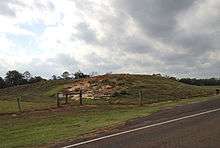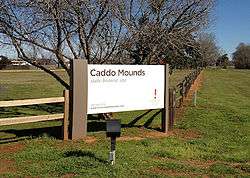Caddo Mounds State Historic Site
|
Entrance to Caddo Mound State Historic Site | |
 Location within Texas today | |
| Location |
Weeping Mary, Texas, Cherokee County, Texas, |
|---|---|
| Region | Weeping Mary, Texas |
| Coordinates | 31°35′49″N 95°9′2″W / 31.59694°N 95.15056°W |
| History | |
| Founded | 780 CE |
| Abandoned | 1260 CE |
| Cultures | Caddoan Mississippian culture |
| Site notes | |
| Excavation dates | 1919, 1933, 1960s–1980s |
| Archaeologists | James Edwin Pearce, E. B. Sayles, H. Perry Newell |
| Responsible body: Texas Historical Commission | |
Caddo Mounds State Historic Site (41CE19) (also known as the George C. Davis Site) is an archaeological site in Weeping Mary, Texas. This Caddoan Mississippian culture site includes a and is composed of a village and ceremonial center that features two platform mounds and one burial mound. Located on the original El Camino Real de los Tejas trail, the settlement predates European and African exploration arrival to the region. Archaeologists believe the site was founded in approximately 800, with most major construction taking place between 1100 and 1300.
The Caddo Mounds site is located 6 miles (9.7 km) west of Alto, Texas on Texas State Highway 21 near its intersection with U.S. Route 69 in the Piney Woods region of east Texas. Operated by the Texas Historical Commission, the museum had its grand reopening in October 2015. The new museum offers visitors a chance to explore a replica Caddo village, and all exhibits are hands-on. Visitors can walk the 0.7 miles (1.1 km) self-guided interpretive trail to see the Caddo’s burial, low temple, and ceremonial mounds. An additional trail along the El Camino Real is also available.
Description


The site began with the founding of a permanent village by the Hasinai,[1] who moved into the region from the Red River area to the northeast, in roughly 850 to 900.[2] The region possessed ideal qualities for the establishment of a village: good soil, abundant food resources, and a permanent water source that flowed into the Neches River.[3] What eventually became the largest mound, Mound A, was begun at this time. It is at the southern edge of the site and was surrounded by about 40 houses. In 1100 a new mound was begun near the center of the site, Mound B, and would eventually measure roughly 175 feet (55 meters) north-south and 115 feet (35 meters) east-west. Mound C, the northernmost mound of the three, was used as a burial mound, not for elite residences or temples like the other two.[4] The site was the southwestern-most ceremonial mound center of all the great mound building cultures of North America.[4]
The settlement was abandoned in the 13th century when the elite ruling class dissipated after the outlying hamlets became more self-sufficient and grew less dependent on the site for religious and political matters. The Caddo culture that remained was similar to the earlier culture in many ways but lacked much of its hierarchical structure and exotic material wealth.[3] By the time Europeans arrived in the area in the 18th century, the Caddo groups in the area lived in small villages and hamlets, spread across the local landscape. They had long since stopped building mounds, and their former hierarchical social and political organization had become much less centralized.[2]
The Hasinai groups continued to live in the Neches and Angelina River valleys up to the 1830s, but by the early 1840s, all Caddo groups had moved to the Brazos River area in an effort to avoid Anglo-American colonization. In 1855 the U.S. government moved them to the Brazos Indian Reservation, and in 1859 moved them to the Washita River in Indian Territory, now western Oklahoma.[3] The Caddo still live in western Oklahoma, Binger, Oklahoma being the capital of Caddo Nation of Oklahoma.
Modern excavations
The earliest recorded mention of the mounds was in 1779 by Athanase de Mézières who traveled from Louisiana to San Antonio in the employ of the Spanish government. James Edwin Pearce was the first professional archeologist to record the site for the Bureau of Ethnology in 1919. In 1933 archeologist E. B. Sayles concluded that the site was a Caddo mound center after conducting surface collection of artifacts at the location.[2] The first scientific excavations were conducted from 1939 to 1941 by H. Perry Newell, a University of Texas archeologist with the Work Projects Administration. When Newell died, archeologist Alex D. Krieger took over investigations at the site and concluded that it had been a major Caddo site. Further excavations in the 1960s and early 1970s by Dee Ann Story pinpointed the timeline of the site to 780 and 1260.[2]
The Texas Parks and Wildlife Department established a historic park in 1974 after acquiring seventy acres of the site and funded a series of excavations in the 1970s and 1980s. As the result of these excavations by the University of Texas at Austin, Texas A&M University, and private contractor Elton R. Prewitt, another twenty-three acres of was added to the park in 1981, and an interpretive visitors center was constructed at the site.[2] In 2008 the 80th Texas Legislature transferred operational control of the property to the Texas Historical Commission.[5]
See also
- Battle Mound Site
- Spiro Mounds
- Caddo Nation of Oklahoma
- List of museums in East Texas
- List of Mississippian sites
References
- ↑ "Caddo Mounds-Texas Historical Commission". Retrieved 2010-02-05.
- 1 2 3 4 5 "Handbook of Texas Online-Caddoan Mounds State Historic Site". Retrieved 2010-02-05.
- 1 2 3 "Brief History-Texas Historical Commission". Retrieved 2010-02-05.
- 1 2 "Caddo Mounds-Sites-Texas Native Skies". Retrieved 2010-02-05.
- ↑ "Caddoan Mounds State Historic Site-Operated by the Texas Historical Commission". Retrieved 2010-02-05.
External links
| Wikimedia Commons has media related to Mississippian culture. |
| Wikimedia Commons has media related to Caddo. |
- Caddo Mounds State Historic Site website
- The Encyclopedia of Arkansas History and Culture (The Caddo Indians)
- The Encyclopedia of Arkansas History and Culture (Indian Mounds)
- A History of the Caddo Indians


